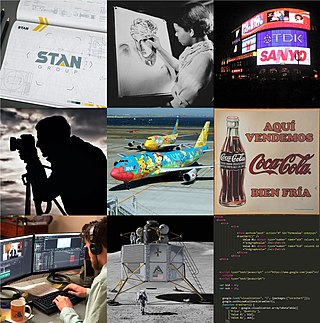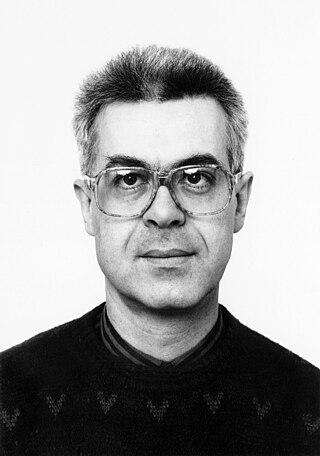Related Research Articles

Graphic design is a profession, academic discipline and applied art whose activity consists in projecting visual communications intended to transmit specific messages to social groups, with specific objectives. Graphic design is an interdisciplinary branch of design and of the fine arts. Its practice involves creativity, innovation and lateral thinking using manual or digital tools, where it is usual to use text and graphics to communicate visually.

Typography is the art and technique of arranging type to make written language legible, readable and appealing when displayed. The arrangement of type involves selecting typefaces, point sizes, line lengths, line spacing, letter spacing, and spaces between pairs of letters. The term typography is also applied to the style, arrangement, and appearance of the letters, numbers, and symbols created by the process. Type design is a closely related craft, sometimes considered part of typography; most typographers do not design typefaces, and some type designers do not consider themselves typographers. Typography also may be used as an ornamental and decorative device, unrelated to the communication of information.

Typographic units are the units of measurement used in typography or typesetting. Traditional typometry units are different from familiar metric units because they were established in the early days of printing. Though most printing is digital now, the old terms and units have persisted.

Information design is the practice of presenting information in a way that fosters an efficient and effective understanding of the information. The term has come to be used for a specific area of graphic design related to displaying information effectively, rather than just attractively or for artistic expression. Information design is closely related to the field of data visualization and is often taught as part of graphic design courses. The broad applications of information design along with its close connections to other fields of design and communication practices have created some overlap in the definitions of communication design, data visualization, and information architecture.
A technical writer is a professional information communicator whose task is to transfer information between two or more parties, through any medium that best facilitates the transfer and comprehension of the information. Technical writers research and create information through a variety of delivery media. Example types of information include online help, manuals, white papers, design specifications, project plans, and software test plans. With the rise of e-learning, technical writers are increasingly becoming involved with creating online training material.
The Society for Technical Communication (STC) is a professional association dedicated to the advancement of the theory and practice of technical communication with more than 4,500 members in the United States, Canada, and the world. The society publishes a quarterly journal and a magazine eight times a year and hosts an annual international conference. STC also provides online education in the form of live Web seminars, multi-week online certificate courses, virtual conferences, recorded seminars, and more.
Communication design is a mixed discipline between design and information-development concerned with how media communicate with people. A communication design approach is concerned with developing the message and aesthetics in media. It also creates new media channels to ensure the message reaches the target audience. Due to overlapping skills, some designers use graphic design and communication design interchangeably.
The ATypI or Association Typographique Internationale is an international non-profit organisation dedicated to typography and type design. The primary activity of the association is an annual conference, held in a different global city each year.

Isotype is a method of showing social, technological, biological, and historical connections in pictorial form. It consists of a set of standardized and abstracted pictorial symbols to represent social-scientific data with specific guidelines on how to combine the identical figures using serial repetition. It was first known as the Vienna Method of Pictorial Statistics, due to its having been developed at the Gesellschafts- und Wirtschaftsmuseum in Wien between 1925 and 1934. The founding director of this museum, Otto Neurath, was the initiator and chief theorist of the Vienna Method. Gerd Arntz was the artist responsible for realising the graphics. The term Isotype was applied to the method around 1935, after its key practitioners were forced to leave Vienna by the rise of Austrian fascism.

The Society of Graphic Designers of Canada officially changed its name to the Design Professionals of Canada (DesCan) in 2021.

The American Institute of Graphic Arts (AIGA) is a professional organization for design. Its members practice all forms of communication design, including graphic design, typography, interaction design, user experience, branding and identity. The organization's aim is to be the standard bearer for professional ethics and practices for the design profession. There are currently over 25,000 members and 72 chapters, and more than 200 student groups around the United States. In 2005, AIGA changed its name to “AIGA, the professional association for design,” dropping the "American Institute of Graphic Arts" to welcome all design disciplines. AIGA aims to further design disciplines as professions, as well as cultural assets. As a whole, AIGA offers opportunities in exchange for creative new ideas, scholarly research, critical analysis, and education advancement.
Philip Baxter Meggs was an American graphic designer, professor, historian and author of books on graphic design. His book History of Graphic Design is a definitive, standard read for the study of graphic design.

The International Council of Design is an international organisation representing the professions of design. The Council was founded in London in 1963 and celebrated its 50th anniversary on 27 April 2013. It is a non-profit, non-partisan, "member-based network of independent organisations and stakeholders working within the multidisciplinary scope of design."
Michael Twyman is a Professor Emeritus of the Department of Typography & Graphic Communication at the University of Reading. He joined the university staff in 1959. He established a BA (Hons) course in Typography & Graphic Communication which eventually grew into its own department in 1974. Both the programme and the department are widely acknowledged to be the first of their kind in the world. He retired from full-time teaching in 1998 but still teaches postgraduate students and is also the Director of the Centre for Ephemera Studies.

Graphic communication as the name suggests is communication using graphic elements. These elements include symbols such as glyphs and icons, images such as drawings and photographs, and can include the passive contributions of substrate, colour and surroundings. It is the process of creating, producing, and distributing material incorporating words and images to convey data, concepts, and emotions.
The Association of Registered Graphic Designers (RGD or simply RGD; formerly ARGD/ON is a non-profit, self-regulatoryprofessional design association with over 3,000 members. It serves graphic design professionals, managers, educators and students. Created in 1996 by an Act of the Legislative Assembly of Ontario, the Association is Canada's only accredited body of graphic designers with a legislated title and the second such accredited body of graphic designers in the world. RGD certifies graphic designers and promotes knowledge sharing, continuous learning, research, advocacy and mentorship.
A style guide is a set of standards for the writing, formatting, and design of documents. A book-length style guide is often called a style manual or a manual of style. A short style guide, typically ranging from several to several dozen pages, is often called a style sheet. The standards documented in a style guide are applicable either for general use, or prescribed use for an individual publication, particular organization, or specific field.

Modern typography was a 1920s principle that expressed a reaction against what its proponents perceived to be a decadence of typography and design of the late 19th century. It is mostly associated with the works of Jan Tschichold and Bauhaus typographers Herbert Bayer, László Moholy-Nagy, El Lissitzky and others.
Fernand Baudin was a Belgian book designer, author, typographer, and teacher. Baudin was active in the field of graphic design in many ways and described himself as a “typographiste”. He was part of national and international typographic organisations, like ATypI, the Graphica-Belgica Prize, and Rencontres internationales de Lure.

Péter Virágvölgyi was a Hungarian typographer, calligrapher, graphic designer, associate professor at the Hungarian Academy of Craft & Design. He was the initiator of the italic handwriting curriculum for elementary schools in Hungary, author of the book A tipográfia mestersége számítógéppel and the designer of the Zeebevel font.
References
- ↑ Rob Waller (2008), "The Origins of the Information Design Association" (PDF), University of Reading, Department of Typography & Graphic Communication, archived from the original (PDF) on 2016-03-03, retrieved 2013-01-30
- ↑ Quoted in Boag, Andrew (2002), What is information design?, Boag Associates
- ↑ Rob Waller (2008), "The Origins of the Information Design Association" (PDF), University of Reading, Department of Typography & Graphic Communication, archived from the original (PDF) on 2016-03-03, retrieved 2013-01-30
- ↑ Horn, Robert E. (2000) [First published 1999], "Information design: the emergence of a new profession" , in Jacobson (ed.), Information Design, MIT Press, pp. 21-22, ISBN 0-262-10069-X